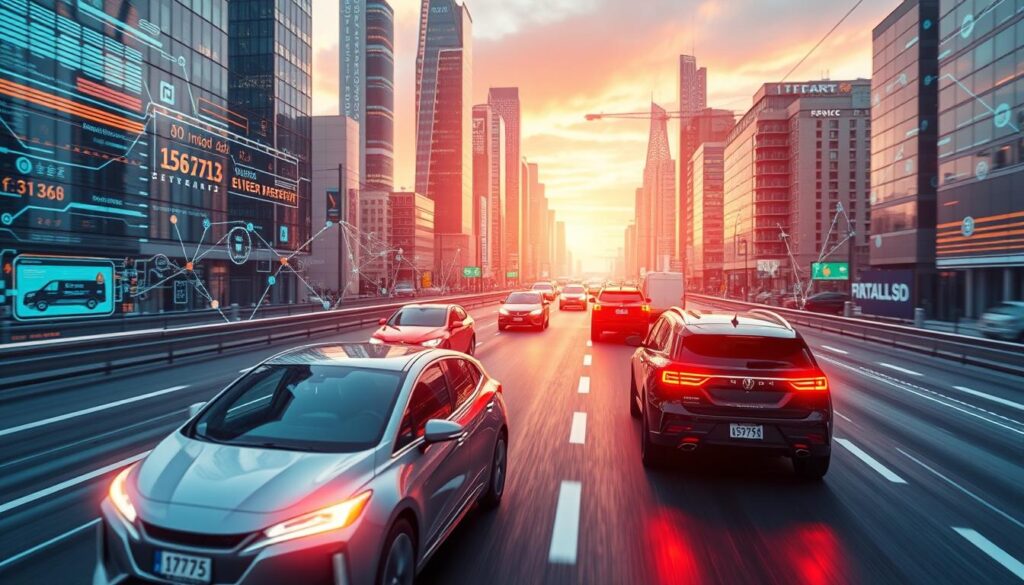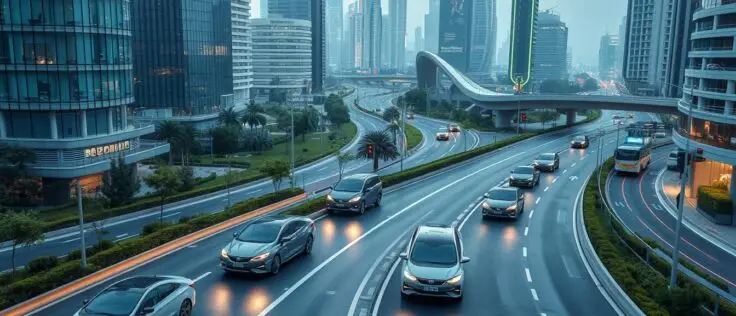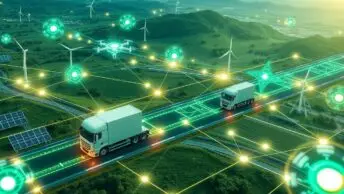The AI in transportation sector is seeing massive changes, transforming our world. Autonomous or self-driving cars are no longer just ideas from stories. They’re now a real part of our streets. These self-driving vehicles are signalling a future where travel is safer, more efficient, and more accessible to everyone13.
Now, big car makers and tech firms are racing to lead in transportation AI. This has sparked a need for more AI skills and knowledge1. Leading companies like Waymo, Tesla, and Mobileye are at the forefront. Their work is helping to create smart cities. These cities use AI to handle huge amounts of data. This is key to building the cities of the future2.
AI in transportation isn’t just about personal cars. It’s changing how goods are delivered, how public transport works, and how traffic flows. This change is thanks to advanced machine learning. Now, travel isn’t just about getting from A to B. It’s about smart data use, making predictions, and everything working together3.
The Pioneering Rise of Autonomous Vehicles
Advancements in technology have sped up the growth of self-driving cars. These changes are significant. They are reshaping how we think about driving worldwide.
From Driver Assistance to Full Automation
Since the mid-20th century, the work on driver assistance laid the foundation. Now, with better computing and sensors, cars can understand and react to their surroundings. Machine learning plays a key role in improving these technologies, helping them learn from data.
The Key Players: Automotive Giants and Tech Disruptors
Big car makers like Tesla and Toyota, along with tech firms such as Google, are leading this tech revolution. They’re not just building the tech. They are also using machine learning to make cars safer and more efficient. Today, these leaders hold a big part of the market in self-driving vehicles4.
Deciphering the Levels of Vehicle Autonomy
The Society of Automotive Engineers lists six levels of car autonomy. It ranges from no automation to full. Most vehicles today are at Levels 2 or 3, offering some automation but still need a human. However, the ultimate aim is Level 5 – a car that operates without any human help. This goal relies on high-tech sensors and smart algorithms, showing a slow but sure move towards fully automated cars.
AI in Traffic Management and Optimisation
The integration of AI in traffic management is transforming how cities handle the ever-growing problem of traffic congestion. By harnessing the capabilities of AI optimisation, these advanced systems facilitate the creation of smarter, more sustainable transportation solutions. Technologies such as AI-based video analytics have been pivotal in the evolution of Active Traffic Management (ATM), significantly improving safety and efficiency on the roads5.
Smart traffic systems go beyond simple monitoring; they actively predict and manage the flow of traffic using real-time data. This includes the use of adaptive traffic signal control systems that adjust timings based on actual traffic conditions, thereby reducing unnecessary stops and enabling smoother transits5.
Furthermore, AI optimisation plays a critical role in reducing overall traffic congestion. Traffic planners use AI technologies to analyse and predict traffic patterns much more effectively5.This proactive approach not only enhances road safety by reducing accident chances. It also helps lower emission rates, aiming for more sustainable transportation5.
Vehicle-to-everything communication (V2X) is another area where AI vastly impacts. It allows for critical information exchange among vehicles, pedestrians, and road infrastructure. This technology greatly enhances traffic management capabilities, leading to truly smart traffic systems5.
The potential of AI in traffic management is also seen in its market growth. The global market for AI in transportation, valued at USD 4.55 billion in 2023, is estimated to hit USD 23.11 billion by 2032. It is growing at a compound annual growth rate (CAGR) of 12.4%6. This growth shows AI’s critical role in optimising traffic flow and boosting traffic systems’ efficiency.
In conclusion, AI-driven innovations in traffic management are not just easing traffic congestion. They’re also leading us to more sustainable and efficient urban living. With ongoing advancements and AI technology integration, smart traffic systems are changing our approach to traffic management and optimisation. They aim for a future with better road safety and fluidity.
Pushing the Boundaries: AI in Logistics and Supply Chain
AI is changing how we manage supply chains, making them more efficient and accurate. It uses advanced analytics and deep learning. This change leads to faster and smarter operations.
Impact on Last-Mile Deliveries: Drones and Robots at Your Service
Drones and robots are making last-mile delivery faster and more reliable. It is happening now, not just in the future. AI reduces mistakes and speeds up deliveries, especially in hard-to-reach places.
Recent advances show AI in logistics cuts down delivery times a lot. This saves resources and makes customers happier7.
Companies like Amazon use AI drones to deliver packages. This shows big improvements in tech and efficiency8.
Streamlining Freight: The Role of Autonomous Trucks
Autonomous trucks are key to better freight transport in supply chains. They use AI to pick better routes and save fuel. This reduces costs and improves delivery times8.
AI also helps keep these trucks running smoothly with predictive maintenance. This means fewer surprises and delays8.
Find out how AI-driven personalised suggestions are changing customer experiences across sectors. Check out this article.
Smart Cities: Urban Planning Meets AI in Transportation
Smart cities grow by blending AI with urban planning and transport. This mix boosts infrastructure and heads towards a green future. It makes city travel smoother.
AI’s role in public transport is transforming how we move. In Singapore, a smart bus routing system saves time and money10. AI helps make travel easy for everyone.
Integration of Public Transportation with AI technology
Dynamic routing and real-time traffic control are now possible thanks to AI. These innovations help buses run on time and more efficiently10. They open doors to travel that’s fair for all city residents.
The Part Autonomous Vehicles Play in Urban Sustainability
In summary, smart cities benefit hugely from AI in planning and transport. It’s fostering cities that are strong, smart, and welcoming. With ongoing AI use in buses and self-driving cars, our cities will become gems of modern design and open travel.
Transportation AI: The Interplay of Data and Machine Learning
The role of machine learning and data analytics in transportation AI has become crucial. Industries aim to use AI algorithms for better efficiency and safety. Data-driven solutions are improving traffic data optimisation, cutting operational costs. This includes reducing fuel use and vehicle wear and tear2. AI also increases safety by foreseeing dangers like accidents and bad weather. This significantly lowers accident rates2
Incorporating AI in transport logistics boosts efficiency and customer happiness. AI, especially chatbots with Natural Language Processing (NLP), learns from user preferences. It makes interactions more personal2. AI’s use in transportation mirrors its effect in areas like marketing. Here, AI and data science merge to create strong, personalised customer experiences and predict trends. Discover more about AI in marketing at Scott Dylan’s blog on technology and1
The transportation area is also exploring complex AI-driven plans like the AI-TraWell project. This project aims at better health and wellbeing. It does so by offering tailored travel options through a smart chatbot system. This shows how tech can help focus on users3

These developments highlight AI’s transformative power in many areas. They streamline work, improve user experiences, and boost safety. As transportation grows, the blend of machine learning, data analytics, and AI algorithms will shape the future of global travel.
Vehicle-to-Vehicle Communication: Paving the Way for Coordinated Transportation
Vehicle-to-vehicle (V2V) communication is changing the game in smart travel. It makes roads safer and helps traffic move better. By talking to each other in real time, cars can make quick, safe choices.
V2V is a key part of wider V2X communication systems. It lets cars share important info like speed and where they’re going. This cuts down on traffic jams and accidents. Studies show V2V could greatly lower crash rates by alerting drivers to dangers near them12.
The Potential of Connected Vehicle Ecosystems
Connected cars do more than just prevent accidents. They create a smoother, cleaner driving experience. By using both V2V and vehicle-to-infrastructure (V2I) tech, vehicles move in harmony. This can lead to less pollution13. Plus, these smart systems allow for new features. For example, cars can drive close together safely, or better control their speed, saving fuel12.
Enhancing Traffic Safety Through Intelligent Communication
V2V’s impact on safety is massive. It gives cars the ability to send and receive crucial data. This reduces the chance of crashes, especially at busy spots like crossroads. Research says V2V can ease traffic and make roads much safer. It does this by warning drivers of possible crashes before they happen1412.
So, as V2V tech grows and merges with connected vehicle systems, driving’s future is bright. This connection aims to improve road safety and traffic management. It’s moving us towards a world where travel is both safe and efficient.
The Regulatory Landscape: Navigating AI Regulations in Transportation
The rise of artificial intelligence is reshaping how we move. With this comes a need for strict AI rules. These rules make sure that as AI changes transport, we stay safe, can rely on it, and trust it.
Establishing Standards for Safety and Liability
This includes matching AI dangers with the right safety checks. For risky uses like self-driving cars or AI in vital services, very strict safety rules are a must16.
Cybersecurity Measures to Protect Autonomous Vehicle Data
Keeping self-driving cars safe from hackers is crucial. The European Union’s AI Act makes special rules for AI that could trick users16. These rules aim to stop abuse and keep user info safe. In the US, the Federal Trade Commission (FTC) is also looking into how AI companies handle our privacy and security15.
Looking ahead, we must carefully combine AI tech with rules that people and society can agree with. It’s important to talk with everyone involved to make fair and strong rules. In doing so, we can ensure AI helps us without harming us.
Mobility Solutions for an Equitable Future
The world of transport is rapidly changing due to more people working from home and choosing to travel alone rather than using public transport17. New technologies are making it easier for everyone to get around, including seniors and those with disabilities. This change is driven by self-driving cars that aim to make travel fairer and more available to everyone17.
In the UK, trials with self-driving electric buses show how new ideas can make travel greener and smarter18. These efforts help cut down traffic and pollution. They also help the planet by making transport cleaner. In the US, AI is being used to make train journeys more efficient, increasing their speed and how much they can carry by up to 20%17.
Putting these advanced technologies into our daily travel means moving towards a future where travel is smooth and eco-friendly. The combination of self-driving cars and AI makes travel safer and more efficient. It also makes sure everyone has equal access to transport. This marks a big step towards a forward-thinking, green transport future.
The Future of AI in Transportation: Milestones and Roadmaps Ahead
AI-driven transportation is moving towards a future with better efficiency, connectivity, and sustainability. Electric vehicles (EVs) and autonomous vehicles (AVs) are joining forces19. This blend is set to transform how we travel, making it greener and smarter.
From EVs to AVs: Sustainable Technological Advances
5G and Beyond: The Role of High-Speed Networks in AV Deployment
5G networks are expanding and becoming key for AI transport projects. They offer vast coverage and top-notch communication between vehicles and everything else19. This growth will help solve current AV challenges, improving road safety and traffic flow.
5G and AI will make transport highly autonomous and efficient. These steps forward will not only enhance city travel but also push for eco-friendly transport tech19.
Public Perspective: Acceptance and Adoption of Autonomous Vehicles
The importance of AVs lies in how the public views and takes them up. How people react to new tech like AVs varies widely. This is because of many reasons, from worries about safety to the good things these cars could bring2122. It is found that three out of four Americans are nervous about totally self-driving cars. This is due to accidents that have happened, making it hard for these cars to be widely accepted21.
To help people accept AVs, it’s crucial to know how AI can figure out what customers. By doing this, AVs can be made to fit the different needs and wants of various places22. For example, in the GCC, where big cars that use a lot of fuel are popular, AVs must suit the local culture and economy to be liked22.
Also, bringing in Level 3 AVs, which handle all driving tasks in some situations, could change how we think about getting around. These cars might make public transport better and lessen city traffic jams22.
The key thing is to make sure AVs change our world for the better. These cars need to win people’s trust by showing they are safe and reliable for daily use2122. By thinking carefully about these issues, we can unlock the full promise of AVs. This could lead to more people embracing them and change how we live in big ways21.
Conclusion
As we stand on the brink of a transport revolution, AI’s growth has started to majorly shape the sector. Reports from top places like Carnegie Mellon University and the University of Michigan shed light on how self-driving tech will change long-haul trips. They foresee a big shift in driver-hours due to AI’s skill in varying weather23. These changes aren’t just altering our present systems but are also sparking talks about a future where we value both people and the planet.
The rise of driverless cars promises progress but also brings challenges in jobs, online security, and city planning23. For example, smarter transport technology could reduce city traffic jams by 20%, making public travel safer and more efficient24. However, we must address serious threats, like AI creating dangerous fake content that could risk safety, with strong laws and readiness from society23.
World leaders and tech heads coming together in the UK shows how critical it is to join forces in this journey towards AI-driven transport25. They stress the importance of updating our infrastructure and being ready technologically25. It’s also crucial for the public to trust these new AI transport options. We are moving into an era where technology and human creativity will drive us towards a future of sustainable and accessible transport. This change marks not just progress, but a significant shift towards a better journey ahead.
FAQ
What are autonomous vehicles?
Autonomous vehicles, or self-driving cars, are equipped with sensors, radars, and cameras. They use artificial intelligence to move without human help. They’re key to evolving transport in smart cities.
How have autonomous vehicles evolved over time?
Autonomous vehicles have grown from mid-20th-century driver assistance systems. Thanks to better computing, machine learning, and sensors, we now have cars with varying autonomy levels.
What is AI’s role in traffic management and optimisation?
AI analyzes traffic data, predicts trends, and manages traffic to reduce congestion. Smart traffic systems powered by AI cut travel times and make traffic smoother.
How is AI transforming logistics and supply chain management?
AI changes logistics and supply chains by finding the best routes and managing stocks. It supports drones and robots for deliveries and autonomous trucks for carrying goods. This boosts efficiency.
What role do autonomous vehicles play in the development of smart cities?
Autonomous vehicles are crucial for smart cities. They offer efficient, easy-to-use public transport, ease traffic jams, and cut emissions. They support sustainable, inclusive transport solutions.
How important is machine learning for transportation AI?
Machine learning is key for transport AI. It lets vehicles understand traffic data, adapt to different conditions, and make smart choices. This tech improves autonomous vehicles’ safety and performance.
What is vehicle-to-vehicle communication and why is it important?
Vehicle-to-vehicle communication lets cars share real-time data on speed, location, and direction. This helps prevent accidents and improve traffic. It’s vital for a smooth, connected transport system.
What are the key regulatory challenges for autonomous vehicles?
The main challenges are setting safety standards, tackling cyber threats, and ensuring AI is used ethically. We need laws to address these issues and safely introduce autonomous vehicles.
How can autonomous vehicles contribute to an equitable transportation system?
Autonomous vehicles improve access to transport for the disabled, elderly, and those without personal transport. By offering reliable transport, they help create a fairer system for everyone.
What technological milestones are ahead for AI in transportation?
Future AI transport tech includes combining electric and autonomous vehicles, enhancing sustainable tech, and using 5G networks. 5G will improve vehicle communication, aiding in deploying autonomous vehicles.
How does public acceptance impact the adoption of autonomous vehicles?
Public support is vital for adopting autonomous vehicles. Safety, reliability, and cultural concerns can influence people. Educating the public and showing autonomous vehicles’ benefits are key to their success and acceptance.
Source Links
- Autonomous Vehicles: Evolution of Artificial Intelligence and the Current Industry Landscape – https://www.mdpi.com/2504-2289/8/4/42
- The Future of AI + Transportation : A Conversation with an Expert – https://www.linkedin.com/pulse/future-ai-transportation-conversation-expert-edem-gold-hdwpf
- AI in Autonomous Vehicles: Transforming Transportation – https://www.unaligned.io/p/ai-autonomous-vehicles-transforming-transportation
- “Generative AI in Autonomous Vehicles Market: Pioneering the Future of Transportation” – https://www.linkedin.com/pulse/generative-ai-autonomous-vehicles-market-pioneering-future-mfebc
- AI in Traffic Management | Isarsoft – https://www.isarsoft.com/article/ai-in-traffic-management
- AI in Transportation: How AI Technology is Revolutionizing Traffic Management – https://litslink.com/blog/ai-and-transportation
- AI in Transportation: Revolutionizing Mobility and Logistics – https://medium.com/@aitechdaily/ai-in-transportation-revolutionizing-mobility-and-logistics-f7ec95e36d18
- AI in Transportation: The Future of Mobility – Startup Nation Central – https://startupnationcentral.org/blog/climatetech/ai-in-transportation-the-future-of-mobility/
- A Closer Look at the Future of AI in Supply Chains – https://www.linkedin.com/pulse/closer-look-future-ai-supply-chains-joel-sellam-j7cuf?trk=public_post
- AI in Urban Planning and Smart City Development – https://medium.com/@jam.canda/ai-in-urban-planning-and-smart-city-development-6cefc3e87181
- Smart Cities & Transportation – Urban AI Solutions – https://urbanaisolutions.com/index.php/smart-cities-transportation/
- Driving Into The Future: Connected Vehicle Innovations – https://www.electronicsforu.com/technology-trends/driving-into-future-connected-vehicle-innovations
- Road to Efficiency: V2V Enabled Intelligent Transportation System – https://www.mdpi.com/2079-9292/13/13/2673
- VCU And Vehicle-to-vehicle (V2V) Communication: Paving The Way For Safer And Smarter Mobility – https://medium.com/@dorlecontrols/vcu-and-vehicle-to-vehicle-v2v-communication-paving-the-way-for-safer-and-smarter-mobility-7c712d65fc2f
- How to navigate global trends in Artificial Intelligence regulation – https://www.ey.com/en_uk/insights/ai/how-to-navigate-global-trends-in-artificial-intelligence-regulation
- The Evolving Landscape of AI Regulations: Insights from the EU, UK, and US – https://www.zartis.com/the-evolving-landscape-of-ai-regulations-insights-from-the-eu-uk-and-us/
- Artificial intelligence in mobility | Arthur D. Little – https://www.adlittle.com/en/insights/viewpoints/artificial-intelligence-mobility
- Creating the balance between existing and future mobility technology – https://www.arcadis.com/en/knowledge-hub/blog/global/simon-swan/2023/creating-the-balance-between-existing-and-future-mobility-technology
- How AI is Shaping the Future of Transportation and Logistics | Zoondia – https://www.zoondia.com/blog/how-ai-is-shaping-the-future-of-transportation-and-logistics/
- The Future of Autonomy is Here, and it’s not Robotaxis | Cleantech Group – https://www.cleantech.com/the-future-of-autonomy-is-here-and-its-not-robotaxis/
- Public acceptance and perception of autonomous vehicles: a comprehensive review – https://www.ncbi.nlm.nih.gov/pmc/articles/PMC7908960/
- Autonomous Vehicles Perception, Acceptance, and Future Prospects in the GCC: An Analysis Using the UTAUT-Based Model – https://www.mdpi.com/2032-6653/15/5/186
- How AI is Reshaping Transportation | The Ripon Society – https://riponsociety.org/article/how-ai-is-reshaping-transportation/
- How Artificial Intelligence Can Shape the Future of Transportation? – https://www.globaltechcouncil.org/artificial-intelligence/how-artificial-intelligence-can-shape-the-future-of-transportation/
- Revolutionising Highways: How AI is Transforming the UK’s Transportation Industry – https://www.adeptnet.org.uk/news/revolutionising-highways-how-ai-transforming-uks-transportation-industry






